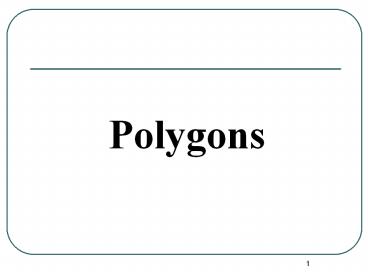Polygons - PowerPoint PPT Presentation
Title: Polygons
1
- Polygons
2
Polygons
Definition
A closed figure formed by line segments so that
each segment intersects exactly two others, but
only at their endpoints.
These figures are not polygons
These figures are polygons
3
Classifications of a Polygon
Convex
No line containing a side of the polygon contains
a point in its interior
Concave
A polygon for which there is a line containing a
side of the polygon and a point in the interior
of the polygon.
4
Classifications of a Polygon
Regular
A convex polygon in which all interior angles
have the same measure and all sides are the same
length
Irregular
Two sides (or two interior angles) are not
congruent.
5
Polygon Names
Triangle
3 sides
4 sides
Quadrilateral
5 sides
Pentagon
6 sides
Hexagon
7 sides
Heptagon
8 sides
Octagon
Nonagon
9 sides
10 sides
Decagon
Dodecagon
12 sides
n sides
n-gon
6
Regular Polygons
- Regular polygons have
- All side lengths congruent
- All angles congruent
7
Classifying Triangles by Sides
Scalene
A triangle in which all 3 sides are different
lengths.
AB 3.47 cm
AC 3.47 cm
AB 3.02 cm
AC 3.15 cm
Isosceles
A triangle in which at least 2 sides are equal.
- Equilateral
A triangle in which all 3 sides are equal.
GI 3.70 cm
GH 3.70 cm
8
Classifying Triangles by Angles
Acute
- A triangle in which all 3 angles are less than
90.
Obtuse
A triangle in which one and only one angle is
greater than 90 less than 180
9
Classifying Triangles by Angles
Right
A triangle in which one and only one angle is 90
Equiangular
A triangle in which all 3 angles are the same
measure.
10
What is a Quadrilateral?
- All quadrilaterals have four sides.
- They also have four angles.
- The sum of the four angles totals 360
- These properties are what make quadrilaterals
alike, but what makes them different?
11
Parallelogram
- Two sets of parallel sides
- Two sets of congruent sides.
- The angles that are opposite each other are
congruent (equal measure).
12
Rectangle
- Has all properties of quadrilateral and
parallelogram - A rectangle also has four right angles.
- A rectangle can be referred to as an equiangular
parallelogram because all four of its angle are
right, meaning they are all 90 (four equal
angles).
13
Rhombus
- A rhombus is sometimes referred to as a slanted
square. - A rhombus has all the properties of a
quadrilateral and all the properties of a
parallelogram, in addition to other properties. - A rhombus is often referred to as a equilateral
parallelogram, because it has four sides that are
congruent (each side length has equal measure).
14
Square
- The square is the most specific member of the
family of quadrilaterals. The square has the
largest number of properties. - Squares have all the properties of a
quadrilateral, all the properties of a
parallelogram, all the properties of a rectangle,
and all the properties of a rhombus. - A square can be called a rectangle, rhombus, or a
parallelogram because it has all of the
properties specific to those figures.
15
Trapezoid
- Unlike a parallelogram, rectangle, rhombus, and
square who all have two sets of parallel sides, a
trapezoid only has one set of parallel sides.
These parallel sides are opposite one another.
The other set of sides are non parallel.
16
Isosceles Trapezoid
- One can never assume a trapezoid is isosceles
unless they are given that the trapezoid has
specific properties of an isosceles trapezoid. - Isosceles is defined as having two equal sides.
Therefore, an isosceles trapezoid has two equal
sides. These equal sides are called the legs of
the trapezoid, which are the non-parallel sides
of the trapezoid. - Both pair of base angles in an isosceles
trapezoid are also congruent.
17
Right Trapezoid
- A right trapezoid also has one set of parallel
sides, and one set of non-parallel sides. - A right trapezoid has exactly two right angles.
This means that two angles measure 90. - There should be no problem identifying this
quadrilateral correctly, because its just like
its name. When you think of right trapezoid,
think of right angles!
18
Quadrilateral Family Tree
Quadrilateral
- Its important to have a good understanding of
how each of the quadrilaterals relate to one
another. - Any quadrilateral that has two sets of parallel
sides can be considered a parallelogram. - A rectangle and rhombus are both types of
parallelograms, and a square can be considered a
rectangle, rhombus, and a parallelogram. - Any quadrilateral that has one set of parallel
sides is a trapezoid. Isosceles and Right are two
types of trapezoids.
Parallelogram
Trapezoid
Rectangle
Rhombus
Isosceles Trapezoid
Right Trapezoid
Square

